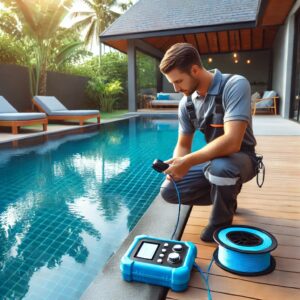When your pool starts losing water, it can be difficult to know where the problem lies. Is the leak in the pool shell, the liner, or somewhere in the underground plumbing? Understanding where the water loss is coming from is the first step to scheduling the right pool leak repair and preventing unnecessary digging or damage. This guide from Pool Patcher® explains how to separate plumbing leaks from structural pool leaks — and what you can do next.

Why Identifying the Leak Source Matters
Not all pool leaks are created equal. A leak in the pool structure (like the liner, tile, or skimmer) behaves differently than a broken underground pipe. Pinpointing the problem helps you avoid paying for the wrong service. For example, calling for a full pressure test when the leak is actually in a liner seam wastes both time and money. Pool Patcher® specializes in diagnostics that isolate the exact cause of your water loss — whether that’s a damaged return line, a cracked fitting, or a worn-out gasket.
Step 1: Rule Out Evaporation First
Before assuming a leak, perform the simple bucket test. Fill a bucket with pool water, set it on the top step, and mark both water levels. After 24 hours, compare the two. If the pool level drops significantly more than the bucket, you likely have a leak. If both drop evenly, it’s just evaporation — a common occurrence during hot New Jersey summers.
Step 2: Inspect Visible Pool Components
Once you’ve confirmed a leak, look for common structural sources:
- Skimmer throat or housing – Cracks in the plastic or separation from the pool wall often cause steady leaks.
- Main drain – A bad seal or loose screw can allow water to escape underground.
- Pool light niche – Older lights can leak through deteriorated conduit lines.
- Tile line and coping – Movement from freezing winters can create hairline cracks around the perimeter.
- Liner seams and steps – Vinyl liners can separate, wrinkle, or tear near steps or corners.
If none of these areas show visible signs of damage, the leak may be hidden in the underground plumbing system feeding your returns, skimmers, or main drain.
Step 3: Perform a Dye Test
The dye test is a simple way to confirm a structural leak. Turn off the pool pump, let the water calm, and carefully squeeze dye near suspected leak points. If the dye is drawn into a crack or fitting, that’s your leak. This method works well for visible areas but cannot diagnose underground pipe damage.
Step 4: Check for Plumbing Leaks Using Pressure Testing
When the pool structure looks intact, plumbing is the next suspect. Pool Patcher® pressure testing isolates each underground line (returns, skimmers, main drain, and cleaner lines) to verify if pressure holds steady or drops. A drop in pressure indicates a break or crack in the line. Specialized electronic equipment is then used to locate the precise point of failure — even several feet underground — without unnecessary excavation.
Signs Your Pool Leak Is in the Plumbing
- Water loss continues even when the pump is off or on (indicating underground plumbing involvement).
- Air bubbles appear in the return jets when the pump is running.
- Wet spots or sinking soil near the pool equipment pad.
- Visible cracks in deck concrete along plumbing runs.
- Unusual gurgling or suction sounds in the skimmer lines.
Signs the Leak Is in the Pool Structure
- Water stops leaking once it falls below a certain level (such as the skimmer mouth or tile line).
- Cracks or gaps visible in plaster, vinyl, or fiberglass surfaces.
- Moisture or discoloration around lights, returns, or steps.
- Liner wrinkles or shifting sections caused by water escaping behind it.
Step 5: Schedule a Professional Leak Detection
If you can’t pinpoint the leak, professional detection is the most accurate option. Pool Patcher® leak detection combines electronic listening devices, pressure testing, and precision sensors to confirm whether the issue lies within your pool shell or plumbing lines. We locate and mark every detected leak before any digging or cutting occurs, saving homeowners from unnecessary repairs.
Step 6: Plan for Repair
After identifying the leak location, your repair strategy will depend on the issue. Structural leaks often involve patching vinyl liners, resurfacing plaster, or sealing cracks. Plumbing leaks may require targeted excavation and pipe replacement. Remember that each test and repair step is billed separately unless you’ve selected a full inspection package. Pool Patcher® explains all costs upfront and guarantees our findings — giving you total confidence in the results.
Preventing Future Leaks
Regular maintenance helps protect your investment. Maintain proper water chemistry, inspect fittings yearly, and avoid letting water levels drop too low. Freeze protection in winter and professional inspections every few years can prevent both structural and plumbing damage.
When to Call Pool Patcher®
If your pool is losing more than a quarter-inch of water per day, don’t wait. Pool Patcher® serves Monmouth, Ocean, Middlesex, and Mercer Counties and specializes exclusively in pool leak repair and detection for residential pools. Our advanced non-scuba equipment locates leaks efficiently — with guaranteed accuracy and transparent set pricing.
Internal Links
Learn more about our pool leak repair services or visit our contact page to schedule your inspection today.



